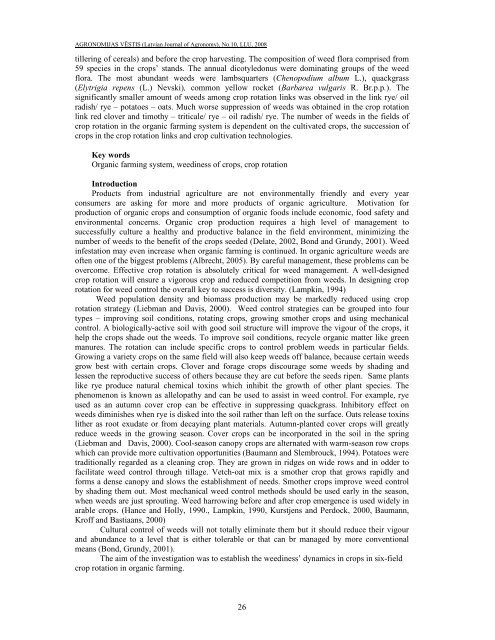AGRONOMIJAS VÄSTIS - Latvijas LauksaimniecÄ«bas universitÄte
AGRONOMIJAS VÄSTIS - Latvijas LauksaimniecÄ«bas universitÄte
AGRONOMIJAS VÄSTIS - Latvijas LauksaimniecÄ«bas universitÄte
- No tags were found...
You also want an ePaper? Increase the reach of your titles
YUMPU automatically turns print PDFs into web optimized ePapers that Google loves.
<strong>AGRONOMIJAS</strong> VĒSTIS (Latvian Journal of Agronomy), No.10, LLU, 2008tillering of cereals) and before the crop harvesting. The composition of weed flora comprised from59 species in the crops’ stands. The annual dicotyledonus were dominating groups of the weedflora. The most abundant weeds were lambsquarters (Chenopodium album L.), quackgrass(Elytrigia repens (L.) Nevski), common yellow rocket (Barbarea vulgaris R. Br.p.p.). Thesignificantly smaller amount of weeds among crop rotation links was observed in the link rye/ oilradish/ rye – potatoes – oats. Much worse suppression of weeds was obtained in the crop rotationlink red clover and timothy – triticale/ rye – oil radish/ rye. The number of weeds in the fields ofcrop rotation in the organic farming system is dependent on the cultivated crops, the succession ofcrops in the crop rotation links and crop cultivation technologies.Key wordsOrganic farming system, weediness of crops, crop rotationIntroductionProducts from industrial agriculture are not environmentally friendly and every yearconsumers are asking for more and more products of organic agriculture. Motivation forproduction of organic crops and consumption of organic foods include economic, food safety andenvironmental concerns. Organic crop production requires a high level of management tosuccessfully culture a healthy and productive balance in the field environment, minimizing thenumber of weeds to the benefit of the crops seeded (Delate, 2002, Bond and Grundy, 2001). Weedinfestation may even increase when organic farming is continued. In organic agriculture weeds areoften one of the biggest problems (Albrecht, 2005). By careful management, these problems can beovercome. Effective crop rotation is absolutely critical for weed management. A well-designedcrop rotation will ensure a vigorous crop and reduced competition from weeds. In designing croprotation for weed control the overall key to success is diversity. (Lampkin, 1994)Weed population density and biomass production may be markedly reduced using croprotation strategy (Liebman and Davis, 2000). Weed control strategies can be grouped into fourtypes – improving soil conditions, rotating crops, growing smother crops and using mechanicalcontrol. A biologically-active soil with good soil structure will improve the vigour of the crops, ithelp the crops shade out the weeds. To improve soil conditions, recycle organic matter like greenmanures. The rotation can include specific crops to control problem weeds in particular fields.Growing a variety crops on the same field will also keep weeds off balance, because certain weedsgrow best with certain crops. Clover and forage crops discourage some weeds by shading andlessen the reproductive success of others because they are cut before the seeds ripen. Same plantslike rye produce natural chemical toxins which inhibit the growth of other plant species. Thephenomenon is known as allelopathy and can be used to assist in weed control. For example, ryeused as an autumn cover crop can be effective in suppressing quackgrass. Inhibitory effect onweeds diminishes when rye is disked into the soil rather than left on the surface. Oats release toxinslither as root exudate or from decaying plant materials. Autumn-planted cover crops will greatlyreduce weeds in the growing season. Cover crops can be incorporated in the soil in the spring(Liebman and Davis, 2000). Cool-season canopy crops are alternated with warm-season row cropswhich can provide more cultivation opportunities (Baumann and Slembrouck, 1994). Potatoes weretraditionally regarded as a cleaning crop. They are grown in ridges on wide rows and in odder tofacilitate weed control through tillage. Vetch-oat mix is a smother crop that grows rapidly andforms a dense canopy and slows the establishment of needs. Smother crops improve weed controlby shading them out. Most mechanical weed control methods should be used early in the season,when weeds are just sprouting. Weed harrowing before and after crop emergence is used widely inarable crops. (Hance and Holly, 1990., Lampkin, 1990, Kurstjens and Perdock, 2000, Baumann,Kroff and Bastiaans, 2000)Cultural control of weeds will not totally eliminate them but it should reduce their vigourand abundance to a level that is either tolerable or that can br managed by more conventionalmeans (Bond, Grundy, 2001).The aim of the investigation was to establish the weediness’ dynamics in crops in six-fieldcrop rotation in organic farming.26
















